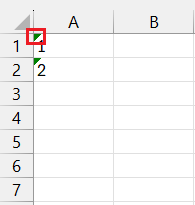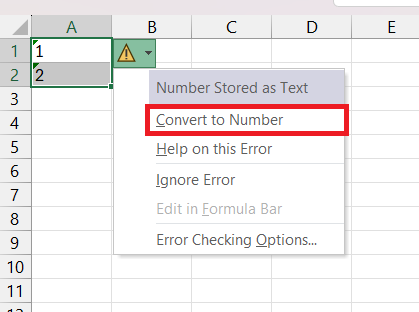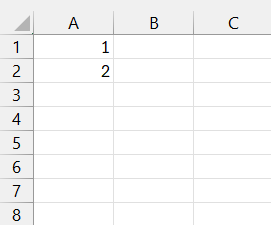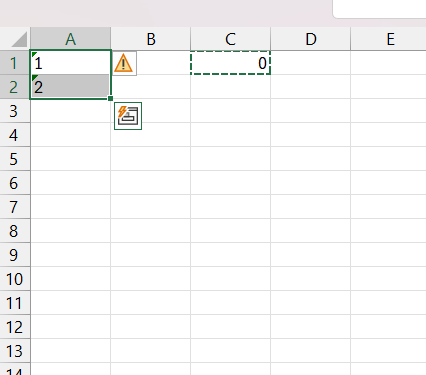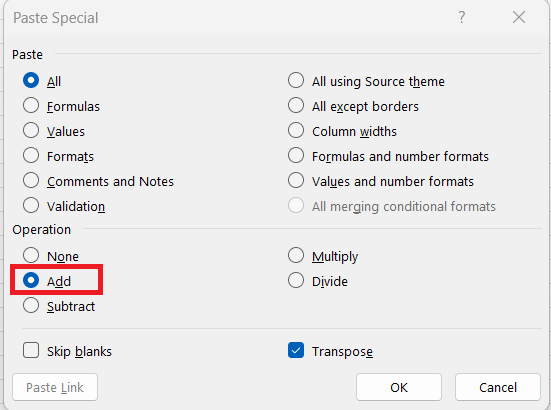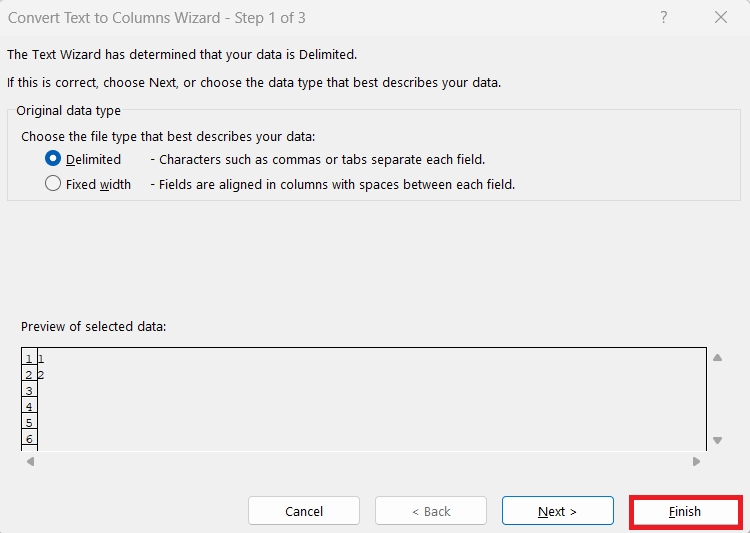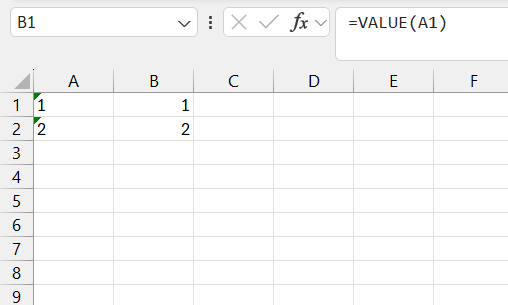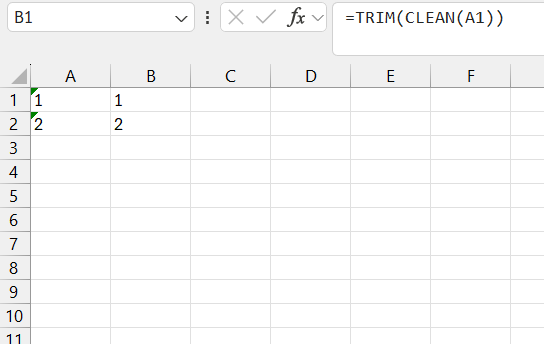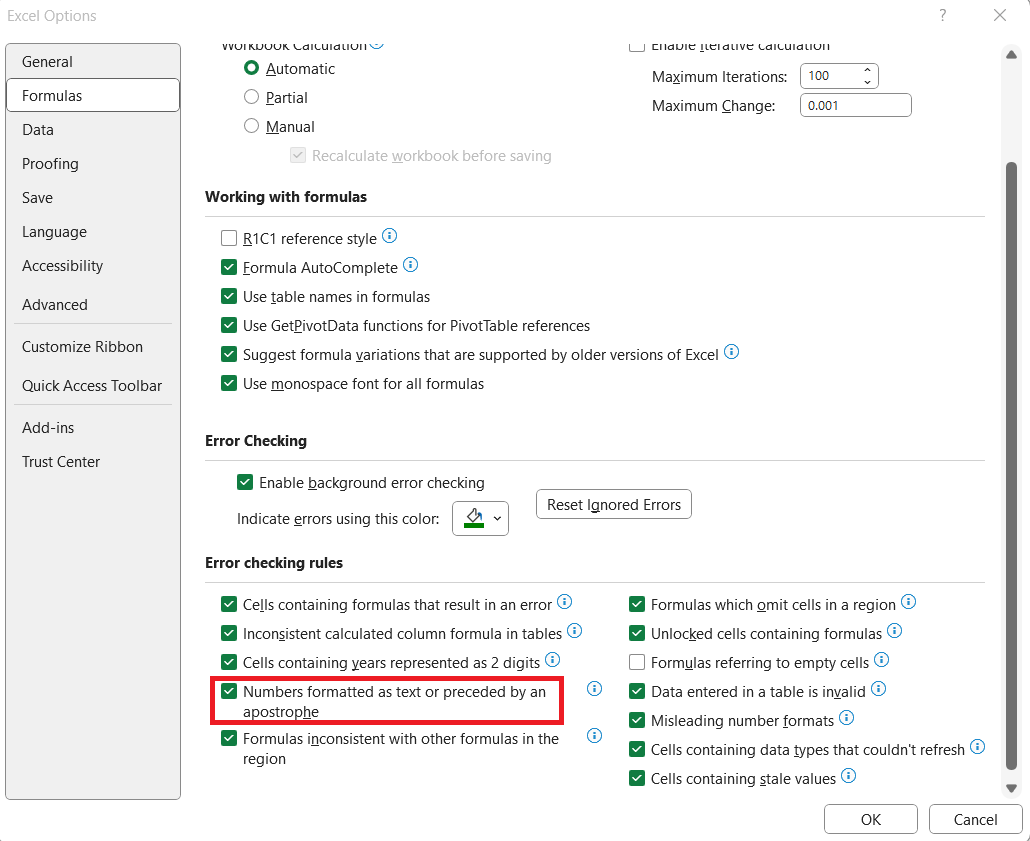Converting text to numbers in Excel is essential when working with datasets where numbers are stored as text, causing errors in calculations and data analysis. Excel offers several methods to quickly convert text-based numbers into usable numerical values. In this guide, we’ll explore these techniques to quickly convert text to number in Excel.
Key Takeaways:
- Use Excel’s “Convert to Number” option for simple fixes.
- Leverage Paste Special and formulas like
VALUE()for more control. - Clean up data using functions like
CLEAN()andTRIM()for seamless conversions. - Prevent future issues by formatting cells as numbers before data entry.
Table of Contents
Introduction
The Excel Quandary: Text That Looks Like Numbers
At some point, almost every Excel user has stumbled upon cells filled with numbers that stubbornly refuse to behave like numbers. It’s like having a car that looks perfect but won’t start—frustrating, right?
This phenomenon occurs when numeric values are inadvertently formatted as text, making them impervious to calculations and other numerical operations.
Why This Guide is Your Excel Toolkit
This guide is crafted to be the Swiss Army knife for all Excel users who’ve hit the wall with text-formatted numbers. I’ve put together practical solutions, beginner to advanced, ensuring that whether you’re performing basic data entry or complex financial analysis, you’ll have the know-how to convert text to numbers with ease.
Thanks to the straightforward explanations and step-by-step instructions, you can expect to not only solve the issue at hand but also gain a deeper understanding of Excel’s nuances. Consider this guide an investment in your Excel proficiency, where the return is measured in saved time and elevated productivity.
Identifying the Issue
Signs Your Data Isn’t Number-Ready
If you notice that your data isn’t cooperating with typical numerical functions, such as summing or sorting numerically, it’s waving a red flag at you. Look out for left-aligned numbers in cells—a classic hint since Excel defaults to right-aligned numeric data.
Another telltale sign is the appearance of the dreaded green triangle in a cell’s top-left corner, signaling that something’s amiss. Also, if your formulas that reference these cells return errors like #VALUE!, it’s a clear indicator that Excel is treating your numbers as text.
Why Excel Misreads Number Formats
Excel misinterprets numbers as a text for several reasons. When importing data from other applications like a CSV file, Excel might not recognize the values as numeric. The same goes for when data is copy-pasted into Excel—sometimes, the source formatting can trip Excel up.
Another common culprit is manual entry; it’s easy to accidentally set a cell’s format to ‘Text’ before inputting numbers. Moreover, formulas may output numbers as text strings, and if cell formatting isn’t properly adjusted, those strings won’t be usable as numbers.
Quick-Fix Excel Methods
The Simplicity of the ‘Convert to Number’ Option
One of the fastest methods to rectify the problem of numbers masquerading as text is the ‘Convert to Number’ option. I find it particularly handy when dealing with data imported from other sources or when numbers have been inadvertently prefixed with an apostrophe during data entry.
A green triangle in the cell’s top left corner usually flags the issue.
To fix it, I simply select the range of cells, click on the warning sign that appears, and choose ‘Convert to Number.’
Just like that, the format changes—numbers align right, and the green triangle vanishes.
Paste Special Magic: Adding Zero to Convert
Now, let’s talk about a rather enchanting trick—using Paste Special to convert text to numbers by simply adding zero. I’m always astounded by how something so simple can be so powerful. First, I enter “0” into any cell, copy it, and then choose the cells with the text formatted numbers.
With a flourish of the ‘Paste Special’ dialogue, selecting ‘Values’ and ‘Add’, the text morphs into actual numbers.
This method is amazing because it leaves the converted numbers right where they were, saving me the hassle of moving them around afterward.
Advanced Problem-Solving Techniques
Text to Columns Wizardry
The Text to Columns feature is a powerful multi-tool in Excel’s arsenal, not just for splitting text across cells but also for transforming those stubborn text representations of numbers into a format that Excel understands.
I appreciate the wizardry of this feature for its simplicity: after selecting my cells of interest, I access the Text to Columns wizard from the Data Tools group under the Data tab.
From there, I forgo any delimiters and data formats by directly hitting ‘Finish.’
It’s a neat trick that often feels like a software sleight of hand but manages to get the job done without any complicated steps.
Crafting Formulas with VALUE Function
While Excel usually recognizes numbers automatically, there are moments when a cell’s stubborn text format needs a gentle nudge. Here’s where crafting formulas with the VALUE function shows its true colors.
I turn to this method when dealing with data that’s consistently labeled or formatted, and I need to involve some elbow grease. With a formula like =VALUE(A2), pasted down a column, I watch as text strings convert to numbers with surgical precision.
This function is essential, especially when dealing with a range of numbers or applying the conversion across multiple cells.
Cleaning and Prepping Text For Conversion
Trim the Clutter: Using CLEAN and TRIM
When it’s time to clean up data, I reach for the dynamic duo: CLEAN and TRIM. These functions take on the unwelcome spaces and non-printing characters like seasoned detectives. The CLEAN function is my go-to for purging invisible gremlins that can wreak havoc in my spreadsheet, often left behind from data imports.
TRIM, on the other hand, takes care of the extra spaces, whether they’re leading, trailing, or in between—the unsightly bloat of my textual data. Merging them into a formula like =TRIM(CLEAN(A1)) ensures my data is spick and span, primed for further processing or conversion.
Sleuthing With Error-Checking Options
Sometimes, Excel’s own error-checking feature feels like having a personal detective for my dataset. I rely on this feature to catch text-formatted numbers that are easy to miss. If I notice the green triangle indicator is missing despite the issues, I delve into the options.
I follow a breadcrumb trail by clicking on ‘File,’ then ‘Options,’ and finally ‘Formulas,’ where I ensure ‘Error checking rules’ is activated with ‘Numbers formatted as text or preceded by an apostrophe’ selected.
After this, any undercover text-disguised numbers stand out, ready to be converted.
FAQs
How do you convert text to number format in Excel?
To convert text to number format in Excel, use the ‘Convert to Number’ error checking option, apply the ‘Text to Columns’ wizard without any delimiters, or use a formula like =VALUE(A1). Another method includes using Paste Special by adding zero to the text-formatted cells.
What is the shortcut for convert to number in Excel?
There isn’t a one-step keyboard shortcut in Excel solely dedicated to converting text to numbers, but you can press Alt + E + S followed by V and then Enter to use Paste Special for the adding zero method. Otherwise, shortcut sequences typically involve navigating menus or error options rather than a single command.
Can I prevent Excel from auto-formatting numbers as text in the future?
Yes, to prevent Excel from auto-formatting numbers as text in future work, you can format the cells in advance. Right-click the range you’ll work with, choose ‘Format Cells,’ and set the format to ‘Number’ before entering data. This ensures Excel treats your entries as numbers from the outset.
How can I apply a formula that can convert both positive & negative values ?
To convert both positive and negative values in text format to numbers, you can use the formula =VALUE(IF(RIGHT(TEXT_CELL,1)="-","-"&LEFT(TEXT_CELL,LEN(TEXT_CELL)-1),TEXT_CELL)). Replace TEXT_CELL with the actual cell reference you are working with. This will handle numbers with a trailing negative sign correctly.
My numbers are still appearing as text after conversion – what can I do?
If your numbers still appear as text after attempting to convert them, double-check cell formatting and ensure it’s set to ‘Number.’ Use the ‘Text to Columns’ wizard or reapply the =VALUE(A1) formula to individual cells. Also, check for non-printable characters using the CLEAN function and remove extra spaces with TRIM. If issues persist, it may be a deeper formatting issue that requires troubleshooting specific to your data set.
John Michaloudis is a former accountant and finance analyst at General Electric, a Microsoft MVP since 2020, an Amazon #1 bestselling author of 4 Microsoft Excel books and teacher of Microsoft Excel & Office over at his flagship MyExcelOnline Academy Online Course.

